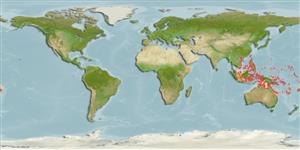Common names from other countries
>
Eupercaria/misc (Various families in series Eupercaria) >
Scaridae (Parrotfishes) > Scarinae
Etymology: Chlorurus: Greek, chloros = green + Greek oura = tail (Ref. 45335).
Environment: milieu / climate zone / depth range / distribution range
экология
морской ассоциированный с рифами; пределы глубины 0 - 35 m (Ref. 90102), usually 5 - 25 m (Ref. 9793). Tropical; 21°N - 25°S, 104°E - 174°W
Indo-Pacific: East Indian region to Micronesia, Samoa, and Fiji and Philippines to Australia; throughout East Indian region except Andaman Sea.
Size / Вес / Возраст
Maturity: Lm ? range ? - ? cm
Max length : 49.0 cm TL самец/пол неопределен; (Ref. 9710)
Краткое описание
определительные ключи | морфология | морфометрия
колючие лучи спинного плавника (общее число) : 9; членистые (мягкие) лучи спинного плавника (общее число) : 10; колючие лучи анального плавника: 3; членистые (мягкие) лучи анального плавника: 9. This species is distinguished by the following characters: median predorsal scales 5-7 (usually 6); 2 scale rows on cheek, 1(6-8), 2(6-8); pectoral-fin rays 15; dental plates well exposed, lips not covering the plates; 1-2 conical teeth on side of upper dental plate; caudal fin truncate. Colour of initial phase (IP) dark brown with broad pale bars on sides and pale caudal fin and caudal peduncle; male with greenish large pale cream patch below eye bordered entirely by a thick green line. Male greenish with pink scale edges, green central zone and outer margins on tail and large rectangular whitish area on cheek; female dark brown with 3-4 broad pale bars (Ref. 9793, 90102, 117228).
Found in clear coastal and inner reefs (Ref. 48636); in lagoons and channel reefs (Ref. 2334). Feeds by scraping algae from the substrate (Ref. 26993). Females usually in small groups and maybe mixed with other species when feeding; males solitary nearby (Ref. 48636). Minimum depth reported taken from Ref. 128797.
Life cycle and mating behavior
Maturities | размножение | Spawnings | Egg(s) | Fecundities | личинки
Oviparous, distinct pairing during breeding (Ref. 205).
Randall, J.E., G.R. Allen and R.C. Steene, 1990. Fishes of the Great Barrier Reef and Coral Sea. University of Hawaii Press, Honolulu, Hawaii. 506 p. (Ref. 2334)
Статус Красного Списка МСОП (Ref. 130435)
CITES (Ref. 128078)
Not Evaluated
Угроза для людей
Harmless
Использование человеком
рыболовство: не имеет хозяйственного значения; аквариум: коммерческий
дополнительная информация
инструменты
Специальные отчеты
Скачать в формате XML
ресурсы в Интернет
Estimates based on models
Preferred temperature (Ref.
115969): 25.8 - 29.3, mean 28.6 (based on 1692 cells).
Phylogenetic diversity index (Ref.
82804): PD
50 = 0.5000 [Uniqueness, from 0.5 = low to 2.0 = high].
Bayesian length-weight: a=0.02754 (0.01419 - 0.05347), b=3.01 (2.83 - 3.19), in cm Total Length, based on LWR estimates for this species & (Sub)family-body (Ref.
93245).
Trophic level (Ref.
69278): 2.0 ±0.00 se; based on food items.
устойчивость к внешним воздействиям (Ref.
120179): средний (среднего размера), минимальное время удвоения популяции 1.4-4.4 года (Preliminary K or Fecundity.).
Fishing Vulnerability (Ref.
59153): Moderate vulnerability (39 of 100).
